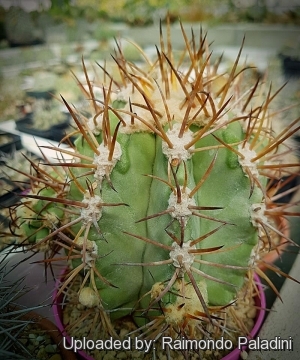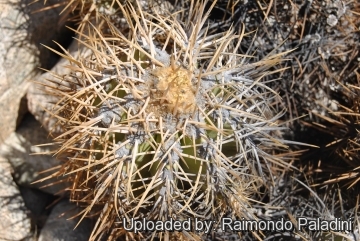Accepted Scientific Name: Copiapoa solaris (F.Ritter) F.Ritter
Kakteen Südamerika 3: 1047 (1980)

Pilocopiapoa solaris (Copiapoa solaris) Photo by: Raimondo Paladini
Blanco Encalada, Atacama desert, Chile, Feebruary 2014. They really are stunning plants and among the most sought after of the Copiapoas. Unfortunately they are incredibly slow at growing (also grafted seedlings are still extremely slow). The plant produces only a few spines each year and the seedling on their own roots are slowest than the aztekiums!
Origin and Habitat: Copiapoa solarisSN|9786]]SN|9786]] comes from the northern part of the range. It is endemic to a restricted area and its population is severely fragmented and there are only two locations centred around the localities of Blanco Encalada and El Cobre, south of Antofagasta (extent of occurrence of 1,500 km2 ). Chile ('El Cobre‘ means 'The Copper‘, reflecting the presence of copper deposits in the area). The populations can be very abundant locally.
Altitude range: It is found at elevations of 600 to over 1,000 metres above sea level.
Habitat: Although found near the coast this is predominately a mountain species. It grows on slopes (lomas costeras), on granitic soils steeply emerging from the ocean and landwards, leading to the barren Atacama Desert up to 1000 m of altitude. They grow in a very arid desert climate with strong oceanic influence and high cloud cover. Characterized by twelve arid months, no frost, an average temperature of 17.2°C and an annual rainfall of only 4 mm!. Rare events of strong rainfalls may occur unpredictably providing a flush of ephemerals growth as well as new seedlings. The extreme aridity is attenuated by the frequent, often dense, coastal fogs. The fog tends to concentrate in the form of a cloud band at an estimated height of 500 to 850 m. It shows a recurrent pattern; usually it is overcast in the early mornings, the clouds dissipating during the late morning and returning during the late afternoons. Winds from SW and S are prevalent. In habitat a very high percentage plants appear to be dead, this is not due to an environmental disaster, but to the preserving desert conditions that are radically different from those common on other natural environments, where dead material would be quickly cleared from the landscape. The process of bacterial decomposition is extremely slow, so that it is likely that the dead clumps are the result of tens if not hundreds of years of decay. The spiny cushions also provide shelter to a great quantity of insects and reptiles. Survival and growth of C. solaris is a remarkable achievement, as it is by far the dominant vascular plant in this bare desert ecosystem. The plant survives by storing water in its roots and body. The major threats are mining and its derivatives like dust. Presumably global climate change is affecting the subpopulations through prolonged droughts that the plants do not survive. The species does not occur within any protected areas. The species is used as an ornamental for specialised collections outside Chile.
Synonyms:
See all synonyms of Copiapoa solaris
back
Accepted name in llifle Database:Copiapoa solaris (F.Ritter) F.RitterKakteen Südamerika 3: 1047 (1980)Synonymy: 6
back
Common Names include:
SPANISH (Español): Cacto Solar
Description: Copiapoa solarisSN|9786]]SN|9786]] is a slowly clumping cactus with a cushion like growth form. They are incredibly slow growing, but old plants in habitat - over centuries - will form large cushion up to 2,30 m of diameter and 90 cm tall with hundreds of heads.
Stems: Individual stems 8-12 cm in diameter, cylindrical green to grey-green with a waxy coating presumably to prevent desiccation in it's extremely dry environment. Offsets appear as white blobs and take about six months to produce a spine or two.
Ribs: 8-12 elevated, up to 3,5 cm tall, not tuberculate.
Spines: Yellow, amber or reddish-brown when young, later chalky-grey, robust, straight or slightly bent, long and interwoven.
Central spines: 2-5, 2-6 cm long.
Radial spines: 7-10, 2-3 cm long.
Flowers: Up to 3 cm long and in diameter, funnelform, yellow, occasionally with a pink or reddish coloured throat. The flowers are often almost concealed among the dense wool and spines at plant apex. Flower tube woolly (Hence the name Pilocopiapoa = hairy Copiapoa). It needs a lot of sunlight to bloom, so it's pretty rare to have blossoms when in cultivation in greenhouses.
Fruits: Woolly, up to 15 mm in diameter.
Subspecies, varieties, forms and cultivars of plants belonging to the Copiapoa solaris group
Bibliography: Major references and further lectures
1) Walter, H.E., Faundez, L., Guerrero, P. & Saldivia, P. 2013. Copiapoa solaris. The IUCN Red List of Threatened Species. Version 2014.2. <www.iucnredlist.org>. Downloaded on 09 November 2014.
2) F. Ritter “Kakteen in Sudamerika” Volume 3. 1980
3) A. Hoffmann, H. Walter “Cactáceas en la flora Silvestre de Chile” Ediciones Fundacion Claudio Gay, Santiago, Chile. Second Edition. 2004
4) G. Charles “Copiapoa. The Cactus file Handbook 4” Cirio Publ. 1998
5) R. Schulz and A. Kapitany “Copiapoa in their environment” Schulz Publishing, Teesdale, Australia. 1996
6) Edward Anderson “The Cactus family” Timber Press, Incorporated, 2001
7) James Cullen, Sabina G. Knees, H. Suzanne Cubey “The European Garden Flora Flowering Plants: A Manual for the Identification of Plants Cultivated in Europe, Both Out-of-Doors and Under Glass” Cambridge University Press, 11/ago/2011
8) David R Hunt; Nigel P Taylor; Graham Charles; International Cactaceae Systematics Group. "The New Cactus Lexicon" dh books, 2006
9) Graham Charles “Copiapoa” Cirio Pub. Services, 1999
 Copiapoa solaris - Blanco Encalada, Atacama desert, Chile, February 2014. (Copiapoa solaris) Photo by: Raimondo Paladini
Copiapoa solaris - Blanco Encalada, Atacama desert, Chile, February 2014. (Copiapoa solaris) Photo by: Raimondo Paladini Pilocopiapoa solaris (Copiapoa solaris) Photo by: Valentino Vallicelli
Pilocopiapoa solaris (Copiapoa solaris) Photo by: Valentino Vallicelli Blanco Encalada, Atacama desert, Chile, feb2014. (Copiapoa solaris) Photo by: Raimondo Paladini
Blanco Encalada, Atacama desert, Chile, feb2014. (Copiapoa solaris) Photo by: Raimondo Paladini Habitat. (Copiapoa solaris) Photo by: Raimondo Paladini
Habitat. (Copiapoa solaris) Photo by: Raimondo Paladini Copiapoa solaris (grafted) (Copiapoa solaris) Photo by: Valentino Vallicelli
Copiapoa solaris (grafted) (Copiapoa solaris) Photo by: Valentino Vallicelli Copiapoa solaris (Own roots 13x18 cm) (Copiapoa solaris) Photo by: Raimondo Paladini
Copiapoa solaris (Own roots 13x18 cm) (Copiapoa solaris) Photo by: Raimondo Paladini Living and dried clumps - Blanco Encalada, Atacama desert, Chile, feb2014. (Copiapoa solaris) Photo by: Raimondo Paladini
Living and dried clumps - Blanco Encalada, Atacama desert, Chile, feb2014. (Copiapoa solaris) Photo by: Raimondo Paladini Copiapoa solaris- Blanco Encalada, Atacama desert, Chile,February 2014. (Copiapoa solaris) Photo by: Raimondo Paladini
Copiapoa solaris- Blanco Encalada, Atacama desert, Chile,February 2014. (Copiapoa solaris) Photo by: Raimondo PaladiniCultivation and Propagation: This extremely slow growing cactus is kept for the beauty of its form. It must be protected from excessive heat and sun in summer, and seems to do best in cultivation with a bit of shade. It requires light but regular waterings in summer, but let the soil mix dry between waterings, Prone to rot if over-watered. Needs good drainage. Keep warm and dry in winter (10°C) to avoid rot. Not highly tolerant of a great deal of frost. (Frost tolerance 0°C)
Propagation: Seeds, but germinating is very slow (often taking a year to germinate) Grafting is often used to speed growth rate and to create a back-up to plants in collection.
Your Photos

by Raimondo Paladini

by Valentino Vallicelli

by Raimondo Paladini

by Valentino Vallicelli























